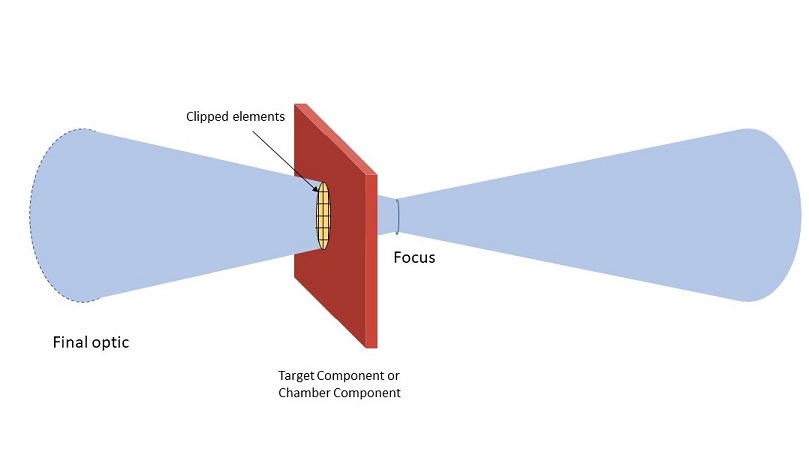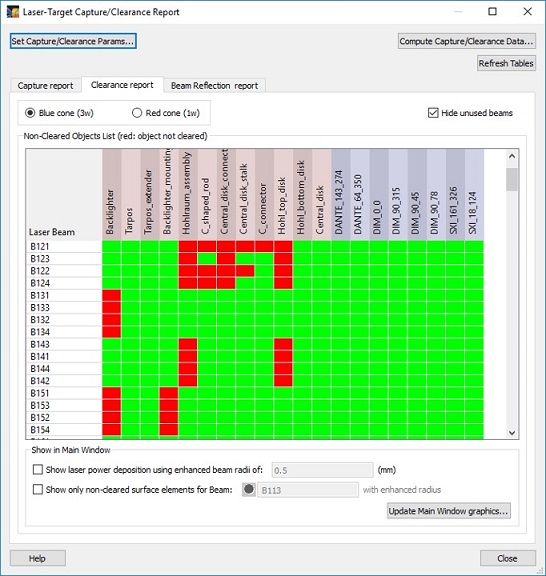
| CONTENTS | GLOSSARY | SUBJECT INDEX | SEARCH DOCUMENTATION |
A summary of which laser beams clear Target Components and Chamber Components can be generated using the Laser Beam Clearance Report.
To generate a report, select the Lasers | Capture/Clearance Assessment, or click on the ![]() tool button.
tool button.
A laser beam cone is considered to clear a Target Component (or Chamber Component) if none of its surface elements is contained within a cone test volume which is specified using:
For each laser beam cone, all Target Components and Chamber Components are checked to see if any of their surface elements lie within the test volume (see illustration below). If any surface elements lie within the test volume, the component fails the clearance test.
Note that if a surface element resides within the test volume, the component fails the clearance test even if it is not hit by the laser beam due to being intercepted by another Target Component. To check to see if a Target Component is hit by a particular beam, view the Laser Beam Capture Report.

The beam clearance report contains a table showing, for each beam cone, which Target Components and which Chamber Components are either cleared (shown as green) or not cleared (shown as red). This allows users to easily see which items fail the clearance test for each beam.

Input for the cleance calculations can be adjusted by clicking on the Set Capture/Clearance Params button.
Input for the blue (3ω) clearance calculations include the intensity threshold to use in defining the outer radius of the cone test volume, and the amount by which the test cone radius is enhanced. This enhancement to the cone radius is applied along the entire length (z-axis) of the cone.
For red (1ω) clearance calculations (for NIF), separate clearance parameters are applied to Target Components and Chamber Components. For the value specified for Target Components, the enhancement applied to the test volume is constant along the cone axis. For Chamber Components, the enhancement to the radius varies linearly with z (i.e., the distance from the focus). In this case, the clearance is specified using two parameters:
Note that user-specified defaults, set in the Config. Check tab in Preferences, can be readily utilized in performing laser beam capture/clearance calculations.
Other parameters that affect the cone test volume are the number of angular (i.e., azimuthal) points, and the number of points along the z-direction (see the Lasers tab in Setting Preferences).
Additional information regarding beam clearance can be obtained using the check boxes at the bottom of the Laser Beam Clearance Report. The laser power deposition intensity on the target grid (i.e., Target Components only) can be shown in the Main Window, where the radius of each beam's intensity profile is enhanced by a specified amount. (If the enhanced radius is zero, the results are the same as obtained when selecting the Display | Direct Laser Power Deposited.)
Also in the Main Window, the surface elements of Target Components and Chamber Components that lie within the cone test volume of a specified laser beam can be displayed. To do this, check the box, and click on the Update Main Window Graphics button.
Simulation results for Laser Beam Capture/Clearance calculations are tracked in a manner that is similar to other simulation results (e.g., radiation temperatures). In the case VISRAD workspace that utilize multiple time steps, the results for each simulation time are stored in memory. However, when changes are made to the grid or laser parameters, the results are set to be out of date.
| Copyright © 2000-2025 Prism Computational Sciences, Inc. | VISRAD 21.0.0 |